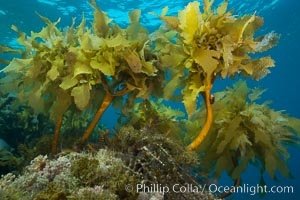Plants and Algae
There are many plants that inhabit the intertidal zone.
http://www.norbertwu.com/nwp/landscape-subjects-for-calendars/CaliforniaCoast_web/originals/1245.JPG
- seagrass, which are the only flowering plants submerged in the ocean, are abundant in the intertidal zone.include the following.
- surf grasses (Phyllospadix spp.)
- eelgrass (Zostera marina),
- Marine algae
- Characteristics/about/general information
- One thing that sets them apart from land plants is their lack of true roots, stems, leaves and flowers.
- Most have a holdfast (the marine algae equivalent of roots), a blade/blades (the equivalent of leaves), and a stipe (which resembles the trunk of a tree or stems of other plants).
- Some have gas filled bladders - scientifically called pneumatocysts - that allow the blades to float close to the surface. This allows maximum exposure to sunlight, which maximizes photosynthesis.
- There is a wide range in size - marine algae ranges from microscopic phytoplankton, which are single celled organisms floating freely in the ocean, to giant kelp, which live in costal, under water forests.
- Types
- There are three phyla are characterized by the dominant pigment coloring the plants.
- Green Algae (Phylum Chlorophyta)
- There are over 7,000 species in this phylum, and they get their color from the photosynthetic pigments Chlorophyll A and B. Green algae grows near the surface, reflects green light while using red light.
- Common green algae found in the intertidal zones include sea lettuce (ulva spp.) (characteristics include being bright green, very thin [ only two cell layers thick}, and translucent), gutweed/hollow green weeds (known as entermorpha spp), (which as flattened green tubes and inhabit the high intertidal zones), and dead man's fingers (codium fragile), which is dark green with finger like blades and lives in the middle intertidal zone to the sub-tidal zone.
- Brown Algae (Phylum Pheaophyta)
- Brown algae get their color from the dominance of the xanthophyll pigment - called fucoxanthin - over chlorophyll A and B. Brown algaw grows in medium depths, uses yellow and green light while reflecting red and blue light.
- There are many species of brown algae that thrive in the rocky intertidal zone. Brown algae additionally has algen, which keeps the plants form drying out. Algen can be used for a wide array of man made uses. It is commercially harvested, and can be used for pharmaceutical uses, in cosmetics, waterproofing and fireproofing clothing, and more. It is also used in food as a thickening agent. Example foods include ice creams, soups, and drinks.
- The types include
- sea potato (leathesia sp ), which is a light brown algae that forms light brown, hollow sacs 5-6 cm in diameter. It is found in the Pacific and Atlantic coasts of North America.
- sea palm (postelsia palaeformis), which are large green-brown algae that resemble land palm trees. They have straight stipes that grow up to 100 stipe-like blades. It can grow up to 61cm - which is about 2 feet - tall. (1) It lives in the middle intertidal zone, a place with high wave activity. (2)
- Giant Kelp ( Macrocystis pyrifera), which grow in the cold, costal waters of North America, South America, South Africa, South Australia. It forms dense underwater forests and grows best in water temperatures with a temperature range between 50-60 degrees Farenheight. (Fun fact: it can grow up to two feet per day.) While it doesn't always live in the intertidal zone, it frequently washes up there.
http://www.norbertwu.com/nwp/landscape-subjects-for-calendars/CaliforniaCoast_web/originals/1245.JPG
- Red Algae (Phylum Rhodophyta)
- The pigments phycoerythrin and phycocyanin produce the red color seen in red algae. Red algae grows deep, reflects green,yellow, and red light while uses blue light.)There are two types
- Coralline Algae (Order Corallinales, Family Corallinaceae)
- They contain calcium carbonate deposits within their cell walls, which give these organism a crusty af texture. Their growth structure may be branching or encroaching, depending on the species.
- Nori
- Nori are single layer thick organisms that are typically a deep purple to black-ish color. Humans use it for the taste and for it's nutritional value.
- https://seaworld.org/animal-info/ecosystem-infobooks/tide-pools/intertidal-marine-plants/
- http://www.oregon.gov/oprd/natres/docs/algae.pdf





Comments
Post a Comment